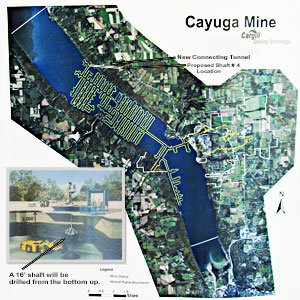- By Dan Veaner
- News
 Print
Print  These renderings show proposed designs for buildings that will contain the new Mine Shaft #4.
These renderings show proposed designs for buildings that will contain the new Mine Shaft #4.| For a look inside the Cayuga Salt Mine click here to view: Lansing Down Under -- A Look at the Cargill Mine | ||
"We are pleased that the DEC has approved our permit for the new air shaft, which is critical for sustained health and safety of our workers," says Mine Manager Shawn Wilczynski. "Cargill followed the rigorous environmental review process established by the DEC. We feel the DEC made the right decision based on science, the information compiled to support permit issuance and the independent analysis completed that ensures the shaft poses no threat of significant environmental impact."
The 100 year old Cayuga Salt Mine is the deepest salt mine in the United States, currently employing 200 people who provide two million tons of rock salt, about half of which is used on roads in New York State. The current shafts, located just north of Portland Point in Lansing, are 2,300 feet deep. Company officials say that the new shaft will mean retaining the 200 current employees, while adding at least four new jobs including new hoist operators and a person to accept materials during the day. A 2014 independent economic analysis found that the mine accounts for an impact of $4.5 million in the Town of Lansing, $173 million in Tompkins County, and $221 million in New York State.
Cargill received a 'notice of complete application' August 29, 2016. That was followed by two public comment periods.
 Click above to view a larger map. Most of the Cayuga Salt Mine is under Cayuga Lake. When drilling begins to create the shaft, it will be done from the bottom. As drilled rock falls to the bottom it will be carted into unused tunnels, minimizing environmental impact on the surface. (Graphics courtesy of Cargill)Cargill officials planned the project so it would have as low an impact on nearby property-owners as possible. Most neighbors won't be able to see the mine shaft, but those who do will see a set of farm-like buildings that contain the shaft, the hoist for raising and lowering the elevator, and locker, shower, and meeting rooms for mine employees. Noise and other impact to neighbors is also expected to be minimal, because it will be excavated from the bottom up.
Click above to view a larger map. Most of the Cayuga Salt Mine is under Cayuga Lake. When drilling begins to create the shaft, it will be done from the bottom. As drilled rock falls to the bottom it will be carted into unused tunnels, minimizing environmental impact on the surface. (Graphics courtesy of Cargill)Cargill officials planned the project so it would have as low an impact on nearby property-owners as possible. Most neighbors won't be able to see the mine shaft, but those who do will see a set of farm-like buildings that contain the shaft, the hoist for raising and lowering the elevator, and locker, shower, and meeting rooms for mine employees. Noise and other impact to neighbors is also expected to be minimal, because it will be excavated from the bottom up."The last thing we want is to have a negative impact," Wilczynski said last April after conducting informational meetings at the shaft site for interested neighbors. "And we certainly don't want to move forward spending $42 million if we think it would have an impact to the mine or an impact to the lake. The environmental assessment was to do the proper diligence to make sure this site is viable to support a shaft. The first thing we did was to drill a core hole and absolutely verify the geology and hydrology in the area, that there are no gas or water pockets."
In July Assemblywoman Barbara Lifton (D/WFP-125AD, Tompkins/Cortland) announced, at a press conference in Stewart Park, that she and NYS Assembly Committee on Environmental Conservation chair Steve Englebright had called on the DEC to enact a moratorium on permits and avoid approving activities that would lead to expanded salt mining under Cayuga Lake. She and others presented a study claiming mining under the lake is hazardous. Lifton said the Cayuga Salt Mine could suffer a catastrophic event similar to the 1994 Retsof, NY salt mine disaster, in which the mine collapsed and flooded with water.
But Wilczynski countered that the data presented at the press conference was nothing Cargill officials hadn't already seen, and noted that the mine conducts its own mine safety reviews each year, as well as receiving at least two or three independent annual reviews, including one from an independent geologist selected by the DEC. He added that the company provides an annual report to the DEC, including a mine stability analysis, and asserted that the DEC has provided "tremendous oversight" of the mine.

Cargill officials say construction will begin as soon as town permits are aquired over the next few months. Constructing the shaft will take about a year. In the first two months an approximately 11 inch pilot hole will be drilled. Over the next three months a circular shaft about 16 feet in diameter will be drilled using a raised bore process, from the bottom up. Extracted materials will be removed to unused nearby tunnels.
"We are thankful for all of those who have been patient and supported Cargill through this process," Wilczynski says. "We take great pride in operating our mine in a safe and sustainable way and look forward to continuing to provide our customers with deicing solutions that save lives, enhance commerce and reduce environmental impact."
v13i32


